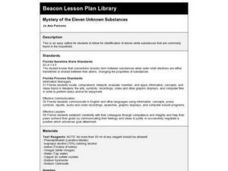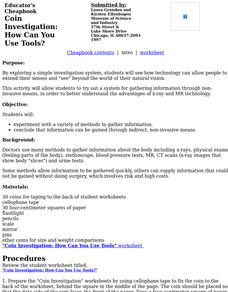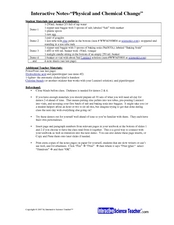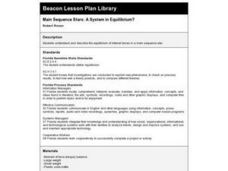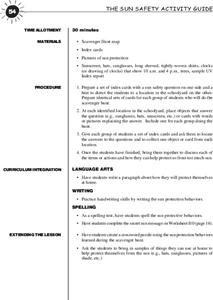Curated OER
ISOLATION OF DNA FROM ONION
Students perform a lab in which they extract DNA from onion cells. Students break through the cell and nuclear membranes and then break down the protein that the DNA is wrapped around.
Curated OER
DNA Isolation
Students use scientific methods to investigate the concept of DNA. They observe the DNA of human cheek cells. This is done with the use of a lab experience. Students record their observations and reflect upon on how each organism is...
Curated OER
Lead Detection
Students hypothesize whether the soil sample may have lead contamination and why. They describe what they see happening with the soil samples and the corresponding swabs. Pupils write a brief description of what they observe as the...
Curated OER
Can Bacteria Arise from Non-living Things?
Fourth graders, in groups, determine whether bacteria arises from non-living things,
Curated OER
Down the Drain
Learners examine the following concepts: If water supplies contain materials which rot or decompose, oxygen is used. Decay and decomposition require vast supplies of oxygen. The use of oxygen for decay of wastes may be a life or death...
Curated OER
Conductors and Insulators
Students explore electrical terms and circuits. In this conductor lesson students divide into groups and complete a lab on electricity.
Curated OER
Michigan's Lumbering history: Yesterday, Today, and Tomorrow
Fourth graders explore lumbering in Michigan. For this lumbering instructional activity, 4th graders examine the life of a modern day lumberjack and how technology can interfere with natural ecology. Students create a list of...
Curated OER
Mystery of the Eleven Unknown Substances
Fourth graders identify eleven white substances that are commonly found in the household. They, in pairs, perform experiments on a variety of substances, and must identify them based on the reactions they observe.
Curated OER
Mud Fossils
Students create their own fossils in an activity using plaster of paris and a variety of objects which can be fossils, e.g. chicken bones, twigs, shells, etc. After making their fossils, they allow them to dry and discuss time and its...
Curated OER
Who Needs What?
Students identify the physical needs of animals and if plants need the same things as animals. They conduct an experiment to see if plants need light and water to grow. They compare the growth of the plants exposed to the different...
Curated OER
Properties of Materials- Leaky Pipe
Learners are presented with a problem of an industrial site is losing water through a pipe leakage. They need to find an appropriate material to seal the joints. Working in groups, they analyze the situation, collect additional...
Curated OER
Football Physics "Having A Ball With Projectile Motion"
Students examine the concept of projectile motion and identify the 3 components of projectile motion. They explore how physics applies to punting a football through punting activities and internet research.
Curated OER
Mapping the Ocean Floor
Students study the bottom structure of underwater habitats and how they can be mapped.
Curated OER
Coin Investigation: How Can You Use Tools?
Students, by exploring a simple investigation system, see how technology can allow people to extend their senses and "see" beyond the world of their natural vision.
Curated OER
Investigate Factors Affecting Nitrates in Groundwater
Students participate in an experiment in which they investigate the factors affecting the levels of nitrates in groundwater. Using examples, they explain the nitrogen cycle and identify the sources of chemical nitrogen fertilizers. ...
Curated OER
Chemical Reaction of Carbonate Rocks and Acids
Students complete an investigation into the chemical reaction that occurs between carbonate rocks and acids. Working in groups, students design and conduct their investigation. They create a data table detailing their results. Results...
Curated OER
Physical and Chemical Change
Students study the differences between physical and chemical changes. In this physical and chemical lesson students complete several labs to help them to see the differences between these changes.
Curated OER
Spectrophotometric Determination of an Equilibrium Constant
Students determine the equilibrium constant for a chemical system and use graphing techniques and data analysis to evaluate experimental data.
Curated OER
The Portable Niche
Third graders, in groups, research animals, plants, and conditions found in ecosystems.
Curated OER
Bean Sort
Students define and discuss dichotomous keys. They create a dichotomous key to identify a bag of mixed beans, and assign their group of beans a genus and species name.
Curated OER
Main Sequence Stars: A System in Equilibrium?
Fourth graders study the equilibrium of internal forces in a main sequence star.
Curated OER
The Sun Safety Activity Guide
Students participate in a scavenger hunt to examine the importance of sun safety. They answer questions from index cards and if they answer correctly they move to a different station. They write a paragraph on how to protect themselves.
Curated OER
Water Above the Ground
Students create a river drainage basin using a plastic tub, sand and a pitcher of water. They simulate the flow of water through the basin then add chocolate syrup to model what would happen if stormwater pollution entered the basin.










